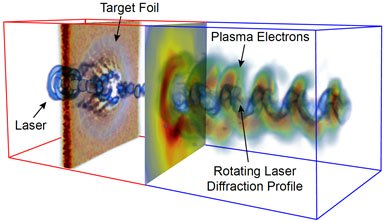Relativistic optics for the control of laser-driven ion acceleration
Area of expertise: Light & other radiation sources for measurements & applications
Due to their compact nature and unique properties (e.g. ultra-short pulse and low emittance), intense laser-driven particle and radiation sources have truly transformative potential for application in many areas of science (e.g. plasma, materials, laboratory astrophysics and ultrafast science) and society (e.g. oncology and imaging solutions for medicine, industry and security). Central to the development of this enabling technology is the exploitation of nonlinear optical phenomena that are produced when plasma electrons interacting with the laser gain relativistic velocities.
The resulting nonlinear optical processes are opening up new opportunities to: (1) dynamically control properties of laser light at ultrahigh intensities; and (2) manipulate the plasma dynamics and field evolution to optimise the unique properties of laser-driven particles and radiation.
A team of researchers led by Prof. Paul McKenna (Department of Physics) are investigating the fundamental physics of relativistic optics and their application to controlling laser-driven ion acceleration. The team have, for example, recently demonstrated that an instantaneous ‘relativistic plasma aperture’ is generated in an otherwise opaque thin foil target at the focus of an intense laser pulse.
The relativistic increase in the mass of the heated plasma electrons, decreases the plasma frequency in a localised region of the target, making it relativistically transparency over a diameter of a few times the laser wavelength. As the laser pulse passes through the resulting aperture it diffracts, enabling the spatial-intensity profile of the resulting beam of relativistic electrons to be controlled. The scheme can also be used to control secondary high energy photon generation.
This research was reported in Nature Physics.
In a follow-on investigation, reported in Nature Communications,the team demonstrated that the diffraction of intense laser light passing through the relativistic plasma aperture can be used to control the acceleration of protons. This opens up a new route to actively controlling the intensity distribution of beams of high energy protons produced via intense laser-foil interactions. Such beams have wide potential applicability, including, for example, as relatively compact sources for proton oncology.
The experiments performed in this programme of research require the use of ultraintense lasers. The team are frequent users of high power laser facilities at the Central Laser Facility, Rutherford Appleton Laboratory and are developing dedicated experimental capability at the new SCAPA (Scottish Centre for the Application of Plasma Accelerators) suite of laboratories.
